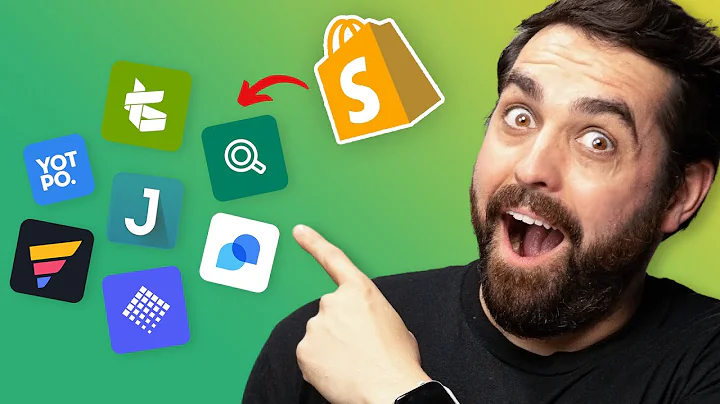Build Your First Online Store in Minutes with Shopify
Table of Contents:
- Introduction
- Signing up for Shopify
- Choosing a theme for your store
- Customizing your store
- Adding a banner image
- Changing the tagline
- Adding a custom logo
- Customizing colors and typography
- Adding products to your store
- Importing products from AliExpress or Printful
- Adding your own products
- Using the AI writing assistant for product descriptions
- Adding high-quality product images
- Setting prices and inventory quantities
- Managing product variants
- Creating collections
- Customizing store pages
- Creating and customizing navigation menus
- Setting up store policies
- Creating policies from templates
- Customizing policies
- Adding policies to the footer menu
- Setting up payment processors
- Setting up shipping rates
- Finalizing store details
- Store name, email, and billing information
- Setting store currency
- Setting up taxes and duties
- Uploading your logo and brand colors
- Setting up a custom domain
- Choosing a Shopify plan
- Going live and launching your store
Article:
How to Build Your First Online Store Using Shopify
Are you interested in building your first online store? If so, Shopify is an excellent platform to help you get started. In this comprehensive guide, we will walk you through all the necessary steps to build your Shopify store from scratch, even if you have no prior experience. So, let's dive in and get started!
1. Introduction
Introduction paragraph...
2. Signing up for Shopify
Signing up for Shopify is the first step in building your online store. It's a simple process that you can easily complete by following the prompts on the Shopify website. To make it even better, we have a special sign-up link in the video description that will give you an additional three months of trial. Take advantage of this offer to save some money and extend your trial period.
3. Choosing a theme for your store
Once you have signed up for Shopify and accessed your dashboard, it's time to choose a theme for your store. By default, the Dawn theme is already installed, but if you prefer a different look, you can browse through Shopify's theme store and select one that suits your brand and vision. In this guide, we will stick with the Dawn theme as it offers a clean and modern design.
4. Customizing your store
Customizing your Shopify store is an essential step to make it unique and appealing to your target audience. Let's start by adding a nice banner image to your home page. By clicking on "Image Banner" and uploading your image, you can instantly enhance the visual appeal of your store.
To further personalize your store, you can change the tagline by clicking on the text and updating it as desired. Adding a custom logo is also crucial for brand identity. Go to the theme settings, upload your logo, and it will be displayed on the left side of the header.
Additionally, you can explore the color and typography settings to use your own brand colors and fonts throughout your store.
5. Adding products to your store
Now that your store is taking shape, it's time to start adding products. If you are dropshipping products from platforms like AliExpress or Printful, you can easily import your products directly. There is a step-by-step tutorial in the video description to guide you through the product import process.
If you have your own products to sell, click on "Add your products" to enter the relevant details like the product name, short description, price, and inventory quantities. If you need help with product descriptions, you can utilize Shopify’s AI writing assistant, which will generate descriptions for you based on a few keywords. Remember to add high-quality images to showcase your products in the best light.
6. Creating collections
Creating collections is a great way to categorize and organize your products. For example, if you are building a clothing store, you can create collections for each product category, such as hoodies, t-shirts, and shorts. In this guide, we will create a manual collection for hoodies.
7. Customizing store pages
As you continue to build your Shopify store, it's essential to customize your store pages. By selecting "Customize" in the online store section, you can access the store editor. Here, you can add sections like a collection list to display your created collections. You can also navigate to different pages and customize them in the same way.
8. Creating and customizing navigation menus
Effective navigation menus are crucial for guiding your customers through your store. By going back to the dashboard and navigating to the online store section, you can access the navigation settings. Here, you can add new menu items and create sub-menus to categorize your products better. For example, you can have separate menus for men's and women's collections.
9. Setting up store policies
Setting up store policies is an essential aspect of running an online store. Shopify makes it easy by providing policy templates that you can customize to fit your specific needs. From refund policies to shipping policies, you can create comprehensive policies that instill trust in your customers. Don't forget to add your shipping policy and contact information as well.
10. Setting up payment processors
To enable your customers to complete their purchases, you need to set up payment processors. Shopify offers various options, including Shopify Payments, which supports different payment methods like credit cards, Apple Pay, and Shop Pay. By default, PayPal is also available, but you can deactivate it if necessary.
11. Setting up shipping rates
To ensure a smooth shipping process, you need to set up shipping rates based on the regions you serve. Shopify allows you to customize shipping rates based on weight or price. If you have imported products, there might already be shipping profiles set up for them.
12. Finalizing store details
Before launching your store, take some time to finalize the store details. Ensure that all the necessary information, such as store name, email, and billing information, is filled out. You can also upload your logo and set your brand colors to maintain consistency. Furthermore, consider setting up taxes and duties, if applicable.
13. Setting up a custom domain
To establish your online presence, setting up a custom domain is essential. If you already have a domain, you can connect it to your Shopify store. If not, Shopify allows you to purchase a new domain directly through the platform. Having a custom domain adds professionalism and brand credibility.
14. Choosing a Shopify plan
Before going live with your store, you need to choose a suitable Shopify plan. The plan you choose will depend on your specific needs and budget. Consider the different features offered and select a plan that aligns with your goals.
15. Going live and launching your store
Congratulations! You have successfully built your first online store using Shopify. The final step is to remove the password, making your store accessible to customers. With all the necessary customization, products, and policies in place, launch your store and start marketing it to attract customers and drive sales.
Highlights:
- Build your first online store using Shopify from scratch.
- Step-by-step guide with easy-to-follow instructions.
- Choosing a theme and customizing your store for a unique brand identity.
- Adding products and creating collections for better organization.
- Customizing store pages and navigation menus for smooth user experience.
- Setting up store policies, payment processors, shipping rates, and finalizing store details.
- Going live with your store and launching it for customers.
FAQ:
Q: Can I build an online store using Shopify without any prior experience?
A: Yes, Shopify is designed to be beginner-friendly, allowing users to build their online stores with no prior experience.
Q: Can I customize the look and feel of my Shopify store?
A: Absolutely! Shopify provides a wide range of themes and customization options to make your store unique and representative of your brand.
Q: How can I add products to my Shopify store?
A: You can either import products from platforms like AliExpress or Printful or manually add your products with detailed descriptions and high-quality images.
Q: Can I accept different payment methods on my Shopify store?
A: Yes, Shopify offers various payment processors, including Shopify Payments, credit cards, and PayPal, allowing you to offer multiple payment options to your customers.
Q: Is it possible to set up different shipping rates for different regions?
A: Yes, Shopify enables you to set up customized shipping rates based on regions and even offers functionality for dynamic shipping rates based on product weight or price.






















